Mixed Experience
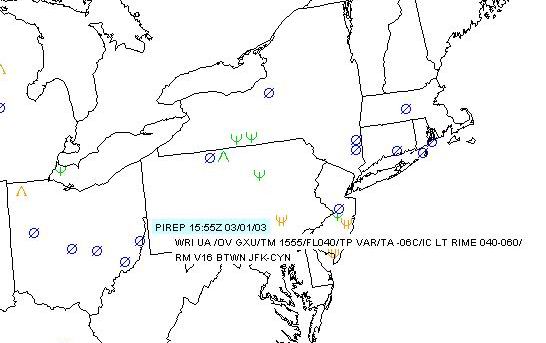
A flight to Nashua, NH one winter day drives home the point that
ice means business.
Weather, Weather, Where are you?
This day started like every other -- the first order of business being a preflight briefing. I had awakened to a beautifully sunny day with temperatures in the 40's. This was unusual only because it was about 15 degrees warmer than normal, but seemingly par for the course in our thusfar mild winter (as I write this, it's 60 degrees outside at 9PM -- what can I say, I'll take global warming anyday!).
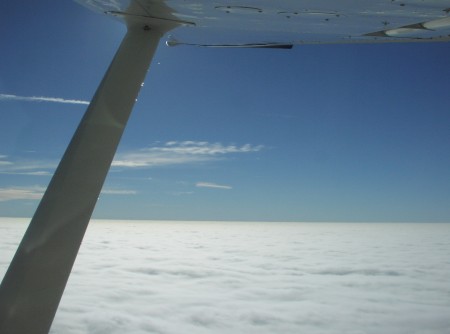 I first
realized this flight might be anything but routine when I
discovered a small obstacle -- a NOTAM indicating the Nashua
Airport was closed except with 15 minutes prior permission
required (PPR in NOTAM-lingo). It turns out all the precipitation
we experienced as rain overnight in New Jersey fell as snow in
New Hampshire, and the Nashua Airport Authority was busy plowing
the airport surfaces.
I first
realized this flight might be anything but routine when I
discovered a small obstacle -- a NOTAM indicating the Nashua
Airport was closed except with 15 minutes prior permission
required (PPR in NOTAM-lingo). It turns out all the precipitation
we experienced as rain overnight in New Jersey fell as snow in
New Hampshire, and the Nashua Airport Authority was busy plowing
the airport surfaces.
Based on my years spent in Nashua, I knew they'd make quick work of the snow removal, but I decided to call the FBO to ask about the situation. The customer service rep told me that the Nashua area had received between 6-8 inches of snow and that the plows were just about done with their task. A second briefing 20 minutes later reflected that as well -- the NOTAM had been rescinded. At that point I knew we were good to go...almost. Some additional weather analysis was required.
The forecast ceilings were all for 4000 feet or better throughout the afternoon, with a possible scattered deck at 2500 feet and unseasonably calm winds (variable at 3-5 knots on the surface). The closest icing airmet within the range of the airplane was over central New York state and Pennsylvania, but I quickly dismissed that as related to the lake effect phenomenon, which seldom influences weather as far south and east as New Jersey.
Oddly enough, between the time I left my house and we took off, a solid overcast deck formed at what I guessed to be around 2000 feet. That was my second clue that the day would have more excitement in store for us. The third clue was the trace of mixed icing we picked up on the climb. Fortunately, the 180HP conversion and cold temperatures gave the 172 spritely performance, and we managed a 1000 FPM climb until we broke out at 4000 feet to find beautifully clear skies and warm sun shining. In fact, it was so sunny and dry aloft that the ice sublimated in less than 30 minutes. Problem averted -- for now, anyway.
Confession
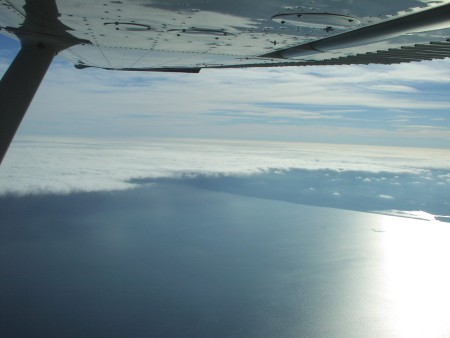 About two hours later we touched down in New Hampshire. Braking
action on the freshly plowed runway was declared "poor", so we
briefed and executed a touchdown at minimum speed without the use
of brakes. We then took care of business, ordered a top-off,
grabbed some lunch, and were soon on our way back home -- this
time through our usual fuel stop of Hartford, CT because of
stronger-than-forecast southwest winds aloft. We flew on top for
most of the trip, and marvelled at how uniform and vast the tops
were -- in all directions, all we saw was a smooth blanket of
clouds several thousand feet below us. Beautiful and serene were
words we used to describe the sight at the time, but I remained
fully aware of the power of even shallow layers of clouds to
produce ice when they want to.
About two hours later we touched down in New Hampshire. Braking
action on the freshly plowed runway was declared "poor", so we
briefed and executed a touchdown at minimum speed without the use
of brakes. We then took care of business, ordered a top-off,
grabbed some lunch, and were soon on our way back home -- this
time through our usual fuel stop of Hartford, CT because of
stronger-than-forecast southwest winds aloft. We flew on top for
most of the trip, and marvelled at how uniform and vast the tops
were -- in all directions, all we saw was a smooth blanket of
clouds several thousand feet below us. Beautiful and serene were
words we used to describe the sight at the time, but I remained
fully aware of the power of even shallow layers of clouds to
produce ice when they want to.
Bradley Approach gave us the usual route to the field, and that meant about 15 minutes of vectors below 4000. We managed to get partial ground contact at 2500 feet, but not before picking up a good 1/8" of mixed ice. Some of the ice began to melt below 1000 feet on the LDA 2 approach, but we nevertheless landed while doing our less-than-stellar impression of an ice cube. Throughout that experience, the defroster managed to keep a 10 inch oval portion of the windshield on the pilot's side clear, but I was blind in the right seat. All I could do was look at the various ice gauges on the airplane, including the leading edge fence, fuel vent, and door stops.
Shortly after we started down the parallel taxiway enroute to the FBO, an aircraft waiting on the runup pad asked us through the ground controller whether we had experienced ice on the approach, and I had to matter-of-factly confess -- "yes sir, we encountered light mixed icing, about 1/8" over 20 minutes". The pilot responded with a dejected "OK, thanks.", no doubt realizing that we'd just made it thoroughly illegal for him (and us, frankly) to fly in the clouds. By the time we got to parking the ice had started to melt and we stepped out with a cloth in hand to inspect the airframe remove what ice remained on the windshield and leading edges.
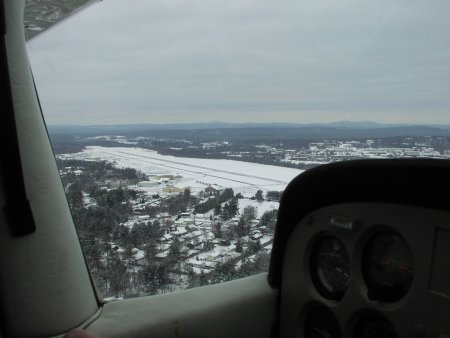 Entering the FBO, I
made a line for the weather console, curious to see what the last
leg held in store. I managed to find only one shallow cloud deck,
with bases varying between 2200 and 2500 feet and tops to around
4000 -- in other words the same stuff we'd been seeing all day.
Visibilities were all 10 or better and winds were less than 5
knots on the surface. The one glaring difference from the earlier
forecasts was that the eastern boundary of the icing Airmet now
consumed the western half of New Jersey and specifically
mentioned mixed icing.
Entering the FBO, I
made a line for the weather console, curious to see what the last
leg held in store. I managed to find only one shallow cloud deck,
with bases varying between 2200 and 2500 feet and tops to around
4000 -- in other words the same stuff we'd been seeing all day.
Visibilities were all 10 or better and winds were less than 5
knots on the surface. The one glaring difference from the earlier
forecasts was that the eastern boundary of the icing Airmet now
consumed the western half of New Jersey and specifically
mentioned mixed icing.
Though our route would technically be to the east of the warning area, I figured we'd get some ice on the way down. But, I also figured New York would keep us high to avoid the Kennedy traffic and grant us the usual crow-bar approach into Old Bridge, which would minimize time in the clouds. And, given the high ceilings (VFR, effectively) I said to myself "Self, even if we do get stuck in the clouds for the last 15 miles, how much ice could a cloud deck 2000 feet thick produce? (insert sinister laugh here). :-) We had a sufficient number of outs and the promise of delightful conditions in cruise, so I made the decision to go.
Homeward Bound
We launched from Hartford into the gray overcast only to pop out at 4000 feet and climb to 6000 feet in clear air. During the climb we heard a guy refuse an IFR clearance to climb through the clouds "due to the freezing level". At that point I made a comment to my crew partner that the guy was smart for not wanting to push his luck in the clouds (and, truth be told, he sounded like a newbie IFR pilot, if that means anything), but sometimes the reward is worth a little risk. After all, it was hard to think about icing as we were basking in the glow of a very warm sun, on top of the clouds in perfectly smooth air -- safer, I argued, than flying all the way to New Jersey at 1500 feet.
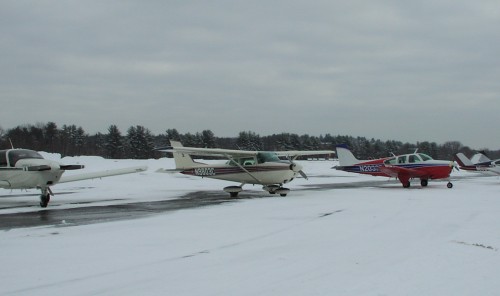 Contributing to our confidence (or perhaps, overconfidence) was
that we didn't get any icing on the climb out of Hartford. I
figured that maybe the heating of the day that evaporated most of
the prior day's moisture had abated, and with it the lift that
contributes to condensation and the propensity for icing.
Contributing to our confidence (or perhaps, overconfidence) was
that we didn't get any icing on the climb out of Hartford. I
figured that maybe the heating of the day that evaporated most of
the prior day's moisture had abated, and with it the lift that
contributes to condensation and the propensity for icing.
After an hour of cruise and shortly after passing Kennedy VOR, New York cleared us to descend to 4000 feet. At 120 KIAS we relished the feeling of flying fast as we gracefully skimmed the tops at 4500 feet. The bliss was short-lived, however, as the warm sun in our faces gave way to ever darkening and colder-feeling clouds as we slowly sank into the undercast. At that point, my attention naturally turned to the various ice indicators on the airplane, and the right wheel pant in particular. You see, the pant sports a darker paint scheme that contrasts nicely with ice, so while pointy objects tend to pick up ice first, I usually notice it on the front of the pant before anything else, particularly in low-light conditions.
Over the next 5 minutes I noticed a rather rapid accumulation of the now familiar mixed variety. We patiently waited for New York to descend us to 3000 or below and turn us over to McGuire approach, but it seemed to take forever (rule of thumb -- time slows to half normal when in icing conditions). Contributing to my concern at this point was a lack of a nearby weather reporting station. Monmouth Executive airport is about 15 miles to the east of Old Bridge, and is usually consulted before we can reach Old Bridge's automated unicom, but Monmouth's AWOS was NOTAMed out of service that day. Sure enough, we received nothing but static, so we had to rely on the base report from Miller Field, a bit farther to the south. Shortly after I heard the report of 2600 overcast and excellent visibility, I knew a visual approach was a real possibility, And, even if we had to prolong the flight by shooting the full approach (at the 1800 minimum procedure turn altitude), I reasoned, exiting the clouds meant exiting the icing conditions.
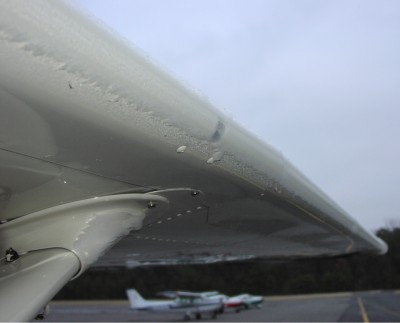 In the time it
took me to perform the cruise check, pick up weather, and set us
up for the GPS 24 approach into Old Bridge (again, just in case),
we managed to accumulate about 1/4 inch on the airplane. At that
point I queried New York and requested lower, to which I received
the anticipated "lower in 5 miles" response. You see, everything
in the ATC system (particularly in New York) happens for a
reason, and in this case the altitudes are dictated by Kennedy
arrivals and departures below us. And no amount of begging short
of the E-word will change things.
In the time it
took me to perform the cruise check, pick up weather, and set us
up for the GPS 24 approach into Old Bridge (again, just in case),
we managed to accumulate about 1/4 inch on the airplane. At that
point I queried New York and requested lower, to which I received
the anticipated "lower in 5 miles" response. You see, everything
in the ATC system (particularly in New York) happens for a
reason, and in this case the altitudes are dictated by Kennedy
arrivals and departures below us. And no amount of begging short
of the E-word will change things.
As I watched our position on the moving map pass the usual handoff point and I looked outside to find at least a 1/2 inch of ice clinging to the leading edge of...well...EVERYTHING, time seemed to slow down even more. I concluded that this was definitely what I'd characterize as a "moderate" rate of accumulation. In the dozen or so times I've found myself in a similar icing scenario, this was a first for me -- and not the kind of first I wanted to celebrate.
Then the call came..."Skyhawk 03C, descend and maintain 3000 and contact McGuire approach on 124.15". Done. Unfortunately, with everyone complaining about the icing situation, it was hard to get a word in edgewise, but I finally managed to check-in. "McGuire, 03C, 3300, descending 3000, and we need 2000 as soon as practical.". We found McGuire a bit more accommodating, as they immediately cleared us down to 2000 feet and direct to the airport for the visual approach. At 2500 feet I called "ground contact", and by 2000 feet had VFR weather minima nailed, so we cancelled IFR. Next order of business -- landing the airplane with a load of ice.
Carrying a Heavy Load
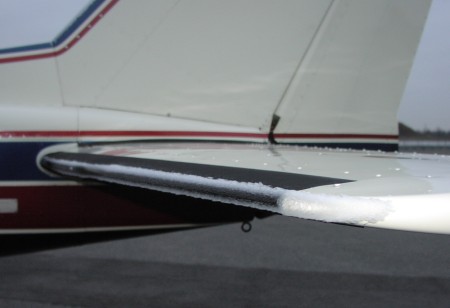 With a STOL kit and modified leading edge, our 172 doesn't really
stall, per se. It mushes, if anything, and just a hint of power
recovers. And, only in the most extreme and provoked of stall
breaks with 40 degrees of flaps do we ever hear the stall warning
horn complain. However, that's with nice, ice-free surfaces.
With a STOL kit and modified leading edge, our 172 doesn't really
stall, per se. It mushes, if anything, and just a hint of power
recovers. And, only in the most extreme and provoked of stall
breaks with 40 degrees of flaps do we ever hear the stall warning
horn complain. However, that's with nice, ice-free surfaces.
The landing briefing focused attention on our efforts to prevent a tailplane stall (or a stall of any kind). We planned to keep the flaps up, maintain 75 knots until the flare, and keep power up as much as practical. We then discussed the slightly wider traffic pattern we'd fly to prevent steep bank angles, the longer final we'd need to accommodate our shallow descent angle, and the effects of our excess speed on the landing runway required. We also took a look out at the leading edge and the ice-covered stall warning inlet to drive home the point that we wouldn't be hearing any whining from the stall warning anytime soon, so this would have to be a "seat of the pants" approach and landing.
Rather than switch pilots at this point, I figured it would be best to let my crew partner fly the approach and landing, while I observed with a slightly more aggressive hunch over the controls, ready to take over if my warnings went unheeded. As I've come to expect from my crew partner, however, the approach went as planned, and all of our practice flaps-up landings made for a smooth and thoroughly controlled touchdown. As we crossed the threshold, our excess speed quickly made it apparent that it would be difficult to make the mid-field turnoff, but rather than go through a set of brakes, we just let it roll all the way to the end. As we turned off, I watched the first few chunks of ice depart the wings and decorate the taxiway. The windshield started to shed ice on the way to the pumps and at that point all I could do was think to myself -- "it's about time!"
Lessons Learned
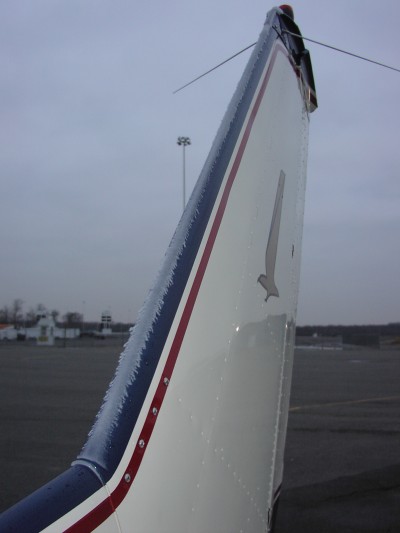 In my previous
icing article I detailed my first encounter with clear icing. I
also gave an account of my experience regarding mixed icing, but
it was nothing more than anecdotal...until now. My first exposure
to mixed icing conditions confirmed my original belief that when
mixed icing occurs, it generally makes its presence known in the
extreme. When pilots report mixed icing, the words "trace" or
"light" are rarely spoken in the same context.
In my previous
icing article I detailed my first encounter with clear icing. I
also gave an account of my experience regarding mixed icing, but
it was nothing more than anecdotal...until now. My first exposure
to mixed icing conditions confirmed my original belief that when
mixed icing occurs, it generally makes its presence known in the
extreme. When pilots report mixed icing, the words "trace" or
"light" are rarely spoken in the same context.
During the summer months, it's quite possible to fly in clouds and see no moisture form on the airplane, while other clouds bathe the airplane in moisture to the extent that it appears like it's raining. I'm convinced our mixed encounter occurred because there was an abundance of moisture below 4000 feet that was the result of the heavy rain and snowfall the previous day, and yet the atmosphere above 4000 feet was so stable the moisture had nowhere to go. It saturated the atmosphere below 4000, creating the relatively thin, but moisture-laden stratus with uniform tops.
This experience also served as a perfect example of why boots work as well as they do for some types of icing, but not so well for others. The vast majority of icing forms in much the same way it formed in this encounter. If you look closely, you'll note that it accumulated only on the forward-most portion of the leading edge of the wings and other appendages. If our 172 had been equipped with boots, I'm convinced they would have made easy work of shedding this particular ice formation.
If you look back at the clear ice examples, however, you'll note that the ice tended to wrap around the leading edges a bit more -- and that was only a very light icing scenario. Get ice behind your boots in a sustained encounter with moderate clear icing (very possible in even light freezing rain), and you're screwed. This has convinced me that the best airplane to handle icing conditions is not a jet with heated leading edges (which can cause moisture to refreeze aft of the protected areas), but a capable airplane with TKS protection that coats nearly the entire airplane. And no, the manufacturer is not paying me to say that. It's just common sense backed up with a bit of empirical data.
Disclaimer: Before you get the wrong idea about this article, allow me to reiterate what I said at the conclusion of my last icing article -- its intent is not to encourage you to go out and screw around in ice, nor does it constitute bragging of any sort. It is merely a way I have chosen to communicate what I've observed and learned from my experience with mixed icing.



